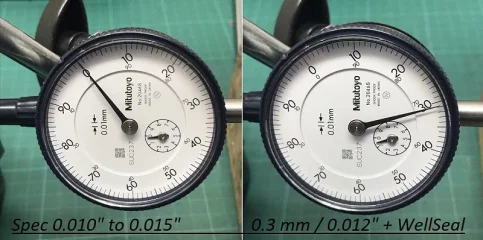- Joined
- Nov 15, 2020
- Messages
- 56
Had satori off and noticed that the crank could move about a 1/8 or a bit more side to side...is this normal or should I be worried..74 850 that's at since 82...also is there a way to bench test the sator
I'll let others argue about crank end float.Had satori off and noticed that the crank could move about a 1/8 or a bit more side to side...is this normal or should I be worried..74 850 that's at since 82...also is there a way to bench test the sator


Good to knowI think a lot over react to end float on the crank, ever Norton motor I have rebuilt had end float and I never worried about it and all the rebuilds I have done mine included are all still going well.
Ashley
TksI think a lot over react to end float on the crank, ever Norton motor I have rebuilt had end float and I never worried about it and all the rebuilds I have done mine included are all still going well.
Ashley
tksI'll let others argue about crank end float.
There are two quick tests for a stator. Wires disconnected. Measure the resistance between the wires on the lowest range your ohmmeter has - the resistance should be quite low. Then measure between each wire and the metal of the stator on your meter's highest range - there should be no reading.
Workshop manual 06.5146 states .005-.015"I'll let others argue about crank end float."
Yes, but with the published specs and the OB tech write up, there shouldn't be an "argument." With a stated 1/8" of float, the OP's crank float is way out of tolerance. I doubt that anyone here would be happy if they sent their Norton motor to some specialist for a rebuild and it came back with 1/8" of crankshaft float!
OTOH...whether somebody chooses to operate it that way is a different issue.
Also, he said 1/8 not 1/8" - decent assumption that he meant 1/8" since he's in the US, but 1/8 of a frog's hair is too tight (according to the "published specs"), not too looseWell...I ASSumed that since the OP stated 1/8" that he measured it to be 1/8"! But as you point out, he didn't specifically say he measured it. SO, L'feat, what is the measured clearance?
No they haven’t...Other threads on this subject have devolved into arguments -
Seems to me you should not have the crank sideplay too tight or too loose, you should aim for the middle ground at 0.XXXX inch.
How’s that the middle when the WSM says 0.010” - 0.024” ?!Seems to me you should not have the crank sideplay too tight or too loose, you should aim for the middle ground at 0.0075 inch.
